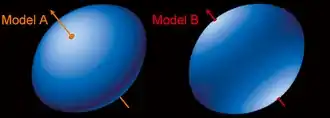Gravity darkening
Gravity darkening, also referred to as gravity brightening, is an astronomical phenomenon where a star rotates so rapidly that it has a detectably oblate spheroid shape, such as in Achernar in the constellation Eridanus.

When a star is oblate, it has a larger radius at its equator than it does at its poles. As a result, the poles have a higher surface gravity, and thus higher temperature and brightness. Thus, the poles are "gravity brightened", and the equator "gravity darkened".[1]
The star becomes oblate (and hence gravity darkening occurs) because the centrifugal force resulting from rotation creates additional outward pressure on the star. The centrifugal force is expressed mathematically as
where is mass (in this case of a small volume element of the star), is the angular velocity, and is the radial distance from the axis of rotation. In the case of a star, the value of is largest at the equator and smallest at the poles. This means that equatorial regions of a star will have a greater centrifugal force when compared to the pole. The centrifugal force pushes mass away from the axis of rotation, and results in less overall pressure on the gas in the equatorial regions of the star. This will cause the gas in this region to become less dense, and cooler.
Von Zeipel's theorem states that the radiation from a star is proportional to the local effective gravity, that is to the gravity reduced by any centrifugal force at that location on the star's surface. Then the effective temperature is proportional to the fourth root of the effective gravity.
References
- Inglis-Arkell, Esther. "The Mysterious Phenomenon of "Gravity Darkening"". io9. Archived from the original on 28 June 2015. Retrieved 28 June 2015.